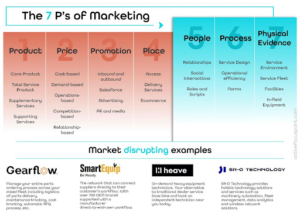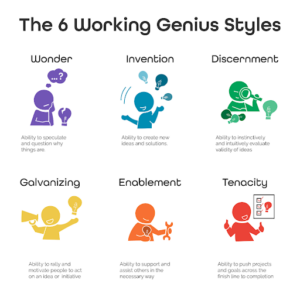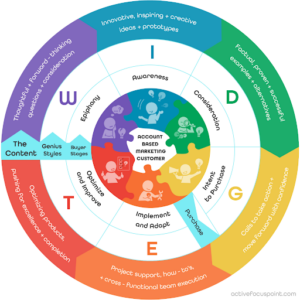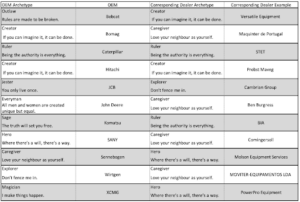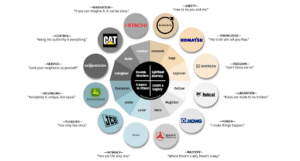The 4Ps Marketing Model Hurts Your Dealership
The 4Ps Marketing Model Hurts Your Dealership
Guest writer Roy Lapa turns our traditional wisdom of marketing on its ear by pointing out how the 4Ps of marketing model hurts your dealership.
The persistence of the 4Ps of marketing within heavy equipment dealerships hurts their future. The 4Ps of marketing represent the following elements: price, place (distribution model), promotion, and product. Without jumping into each of the 4Ps, I will focus on the current dealership situation and the respective challenges facing many dealers worldwide. Further, I will turn towards the 7Ps of service marketing which include three essential additional elements: people, process, and physical evidence (service environment). A dealership needs a strategic level transformation to reap the full benefits of the 7Ps service marketing mix.
Current dealership scenario
In analysing 15+ of the largest heavy equipment dealers in Europe, the USA, and Canada, one finds that the vast majority focus their efforts on selling:
- OEM equipment within a dealership contract—mostly within an exclusive region, established industry, and size class
- Genuine OEM parts
- Factory-authorized service on a per-hour basis, labour blocks, maintenance and repair contracts, preventative maintenance contracts, and unscheduled breakdowns for respective OEM
- Equipment rentals, respective OEM, via a subsidiary or in-house, with a bias toward using this option to sell equipment.
Further, most dealers enshrine selling new equipment, making it a top priority. Despite the dealers’ promotional materials, many behave in a way that, unfortunately, assumes parts and service sales will be “captive” once the equipment arrives in their market.
Macro-environment challenges and opportunities for dealers
As most of the world’s major economies transform towards service-based economies, the service sectors will account for anywhere between 40% and 93% of their respective GDP and between 50% and 90% of all new jobs. (Paul) Will we view this as a challenge or opportunity?
- The increased demand for customized end-to-end services within all major economies attracts a significant amount of disruptive and innovative competition and solutions. Solutions that provide traditional dealer services and, more importantly, customer services not currently offered by dealership go-to-market models.
- The data currently shows most dealers winning only 35-40% of the post-equipment product support services.
- The prevailing referenced 4P’s used to establish Go-To-Market (GTM) strategies in many manufacturing industries (“John Deere Marketing Mix”) result in a significant negative influence on the dealership’s GTM approach. Why the negative influence? The outdated model ignores several major factors, especially in a service-based market environment.
Industry opportunities and challenges for dealers
A quick recap of five major trends happening in 2023 (“Five Equipment Dealership Trends That Will Shape 2023”) highlights a deep need for dealers to rapidly transition towards a customer-centric, service-based model.
- Online sales and rentals will increase significantly. In 2020, Volvo CE began allowing customers to pre-order new electric equipment online, and they recently launched an online configuration tool for those machines, which allows customers to “build and price” their ideal model.
- Electrification will disrupt the dealer’s revenue model. Grand View Research reports an expectation of global off-highway electric vehicle market of reaching $42.70 billion by 2030. Growth will result from lower operating costs as well as improved battery technology and lower battery costs. The cost of parts drops by about 90 percent, so if your operating costs for a skid-steer were $20 an hour, which drops to $3 per hour.
- Connected machines and jobsites will continue to reduce ownership and operating costs. Sixty percent of Volvo’s connected machines use the company’s advanced telematics system called ActiveCare Direct. These machines are monitored 24/7/365 for alarms indicating an issue. Actionable information (an ACD case) alerts a customer’s equipment manager and the local dealer within minutes. Included information will also help the customer address the issue without the help of a dealer.
- Technology will bring greater efficiency to parts and service. OEM dealer market share for parts has dropped to 35–40%, about half previous years. Luke Powers, CEO of Gearflow, believes dealers will soon compete directly with Amazon. “MRO supplies became the first entry point for Amazon coming into the industrial markets.”
- Rental continues to grow, while an Equipment-as-a-Service model draws significant interest. Construction equipment rental revenue grew by ~12.5% in 2022, surpassing $41.6 billion, with growth forecasts of 7% in 2023, 2% in 2024, 3% in 2025, and 3% in 2026.
Introducing the 7Ps service marketing model
To keep it simple, I built an illustration of the 7Ps service marketing model and included some current disruptive examples in the heavy equipment dealership world. The model, introduced in 1981, (Pervaiz) has successfully created sustainable advantages for many organizations (Rebaz et al.).
7Ps service marketing model helps you compete.
Reorient your dealership model to 7Ps service marketing quickly. Customers want strategic and invested end-to-end partners to help them achieve their business goals.
The examples given in the 7Ps service marketing illustration give you some strong examples of how to expand your services beyond the conventional dealership model and consider further vertical and horizontal integration within your primary industry. Though I have not covered the details of transforming your dealership, you have enough examples to get you moving.
Works Cited, Referenced & Non-affiliation.
Paul Patterson. Services Marketing. Pearson Australia, 2015.
Pervaiz, K. Ahmed. “Using the 7Ps as a generic marketing mix: an exploratory survey of UK and European marketing academics. Marketing Intelligence Planning 13 No. 9, 1995.
Rebaz, Khaleel, et al. The Role of Services Marketing Mix 7Ps on Achieving Competitive Advantages the Case of Paitaxt Technical Institute in Kurdistan Region of Iraq. TEST Engineering and Management 83, 2020.
“John Deere Marketing Mix.” Blog.Notesmatic, 30 June 2022, blog.notesmatic.com/john-deere-marketing-mix.
“Five Equipment Dealership Trends That Will Shape 2023.” AEM Tradeshows, www.conexpoconagg.com/news/the-five-equipment-dealership-trends-that-will-sha. Accessed 26 Apr. 2023.
Note, I am not affiliated with or in any way compensated for the companies mentioned within the article.


